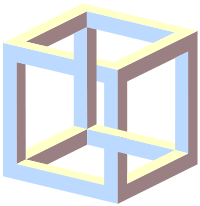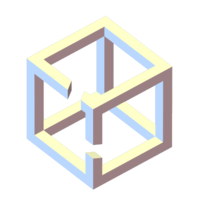Impossible cube


The impossible cube or irrational cube is an impossible object invented by M.C. Escher for Belvedere, a lithograph in which a boy seated at the foot of the building holds an impossible cube.[1][2] The rest of the scene is based on the same principle that makes the impossible cube: a ladder from the inside of the first story leads to the outside of the second. However, this is not appreciated by the prisoner in the basement cell because the basement is a possible cuboid and he is unambiguously on the inside.
The impossible cube draws upon the ambiguity present in a Necker cube illustration; an impossible cube is usually rendered as a Necker cube in which the edges are apparently solid beams. This apparent solidity gives the impossible cube greater visual ambiguity than the Necker cube, which is less likely to be perceived as an impossible object. The illusion plays on the human eye's interpretation of two-dimensional pictures as three-dimensional objects. It is possible for three-dimensional objects to have the visual appearance of the impossible cube when seen from certain angles, either by making carefully placed cuts in the supposedly solid beams or by using forced perspective, but human experience with right-angled objects makes the impossible appearance seem more likely than the reality.[3]
Other artists than Escher, including Jos De Mey, have also made artworks featuring the impossible cube.[4] A doctored photograph purporting to be of an impossible cube was published in the June 1966 issue of Scientific American, where it was called a "Freemish crate".[3][5] An impossible cube has also been featured on an Austrian postage stamp.[6]
See also
References
- ↑ Bruno Ernst (Hans de Rijk) (2003), "Selection is Distortion", in Schattschneider, D.; Emmer, M., M. C. Escher's Legacy: A Centennial Celebration, Springer, pp. 5–16.
- ↑ John D. Barrow (1999), Impossibility: The Limits of Science and the Science of Limits, Oxford University Press, p. 14, ISBN 9780195130829.
- ↑ 3.0 3.1 Nancy E Smith (1984), "A new angle on the freemish crate", Perception 13: 153–154, doi:10.1068/p130153, PMID 6504675.
- ↑ Jos De Mey (2003), "Painting After M. C. Escher", in Schattschneider, D.; Emmer, M., M. C. Escher's Legacy: A Centennial Celebration, Springer, pp. 130–141.
- ↑ C. F. Cochran (1966), "Letters", Scientific American 214: 8.
- ↑ Robin J. Wilson (2001), Stamping Through Mathematics, Springer, p. 102, ISBN 9780387989495.